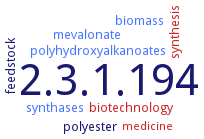2.3.1.194: acetoacetyl-CoA synthase
This is an abbreviated version!
For detailed information about acetoacetyl-CoA synthase, go to the full flat file.

Word Map on EC 2.3.1.194 
-
2.3.1.194
-
polyester
-
mevalonate
-
synthases
-
synthesis
-
polyhydroxyalkanoates
-
biomass
-
biotechnology
-
feedstock
-
medicine
- 2.3.1.194
-
polyester
- mevalonate
- synthases
- synthesis
- polyhydroxyalkanoates
- biomass
- biotechnology
-
feedstock
- medicine
Reaction
Synonyms
AACS, Acetoacetyl-CoA synthase, Acetoacetyl-CoA synthetase, acetoacetyl-coenzyme A synthase, acetoacetyl-coenzyme A synthesizing enzyme, More, NphT7, nphT7SCL, thiolase superfamily acetoacetyl-CoA synthase
ECTree
Advanced search results
Cloned
Cloned on EC 2.3.1.194 - acetoacetyl-CoA synthase
Please wait a moment until all data is loaded. This message will disappear when all data is loaded.
co-expression of polyhydroxyalkanoate synthase, PhaC, from Ralstonia eutropha with acetoacetyl-CoA synthetase in Escherichia coli and Corynebacterium glutamicum leading to enhanced production of polyhydroxybutanoates, by cloning the AACS gene into the phaABC operon of Ralstonia eutropha. Overexpression of AACS leads to a great enhancement of the malonyl-CoA pool in Escherichia coli
-
gene nphT7, functional recombinant expression in sugarcane (Saccharum sp.) cultivar Q117, coexpression of gene nphT7 with genes phaB and phaC
gene nphT7, organized in the mevalonate pathway gene cluster, functional expression in Streptomyces albus, overexpression of N-terminally His8-tagged enzyme in Escherichia coli
-
gene nphT7, recombinant expression in Saccharomyces cerevisiae strain CEN, analysis of the effect of acetoacetyl-CoA synthase on growth as well as the production of farnesene and compares different homologues regarding their efficiency
recombinant expression of AACS in Corynebacterium glutamicum and Escherichia coli leads to aquired ability to form poly(3-hydroxybutyrate) in the transformed organisms by 19.7 wt% and 10.5 wt%, respectively, biosynthetic pathway, overview
-


 results (
results ( results (
results ( top
top





